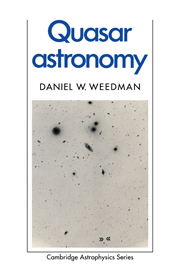Summary
The discovery of quasars nearly a quarter of a century ago made a new science out of astronomy. There were two factors in this invigorating revolution. One was the conceptual shock of learning that some very important sources of energy exist in the universe that are not related to the nuclear fusion processes in stars. The other was the fact that the discovery was made with a new technology, in this case radio astronomy. For the theorist, there was suddenly an open season for wide ranging and creative speculations on cosmological processes, energy generation, and radiation physics. For the technologist, there was proof that opening new observational spectral windows could reveal extraordinary and totally unanticipated things. Radio astronomy was quickly followed by ultraviolet, infrared and X-ray astronomy.
That first phase of the theoretical and technical regeneration of astronomy is now complete. Astronomers are more open to heretical theoretical suggestions and unconventional observational techniques. Exceptional telescope facilities are at our disposal worldwide and in space. Two decades of effort have not answered all of the fundamental questions about quasars, nor have they led to the discovery of objects any more puzzling. We still have the problems, but we now have the tools, and so can get on with the work of learning what, where, when, and why are the quasars.
My initiation into the subject began during a few spare hours left over from another project while observing with the 36-inch telescope at McDonald Observatory, in the fall of 1967.
- Type
- Chapter
- Information
- Quasar Astronomy , pp. xi - xivPublisher: Cambridge University PressPrint publication year: 1986



